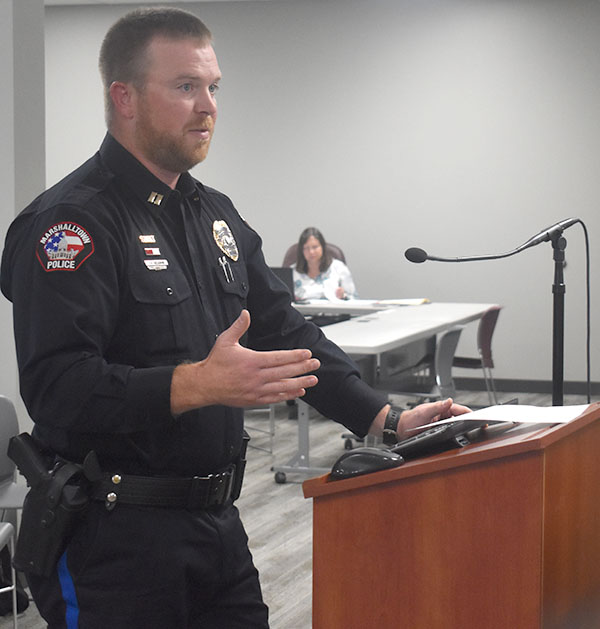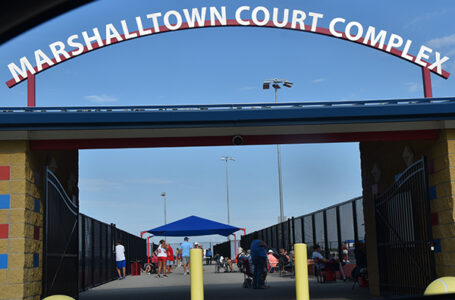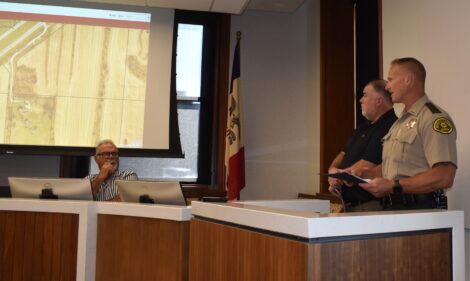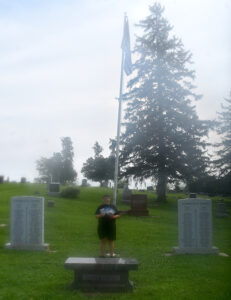MPD captain presents to council on Flock public safety cameras

T-R PHOTO BY ROBERT MAHARRY Marshalltown Police Department Capt. Kiel Stevenson spoke to the city council about a proposal to purchase 32 Flock cameras and place them around the community’s main entry and exit points during Monday night’s meeting. The council voted unanimously to move forward with the purchase and bring back a formal resolution.
Marshalltown Police Department Capt. Kiel Stevenson presented a proposal for the potential purchase of 32 Flock public safety cameras to be placed throughout the community as a crime deterrent and investigative tool during Monday night’s city council meeting.
Last year, the council designated $150,000 to allow the MPD to explore options for upgrading its current camera system and increasing its coverage. According to Stevenson, the committee that was formed discovered challenges with infrastructure and equipment which has become outdated.
Stevenson said they reached out to the police departments in Dubuque and Ottumwa — both currently utilize expansive camera systems — for guidance on what might be the best course of action in addition to other communities that have license plate reading technology. He clarified, however, that it was not Automated Traffic Enforcement (ATE) and did not collect identifying information on the occupants.
“From a privacy issue, this is capturing just vehicle make and model information. There’s no facial recognition or anything like that. It’s just vehicles,” Stevenson said.
After conducting research on various options, the MPD is seeking to partner with Flock because the company has been used by a host of other agencies in Iowa and across the country already and provides full service maintenance. The department doesn’t have a maintenance contract with its current system, so issues don’t become known until something has gone down.
As they would provide 24/7 coverage, Stevenson called the cameras a “force multiplier” that would help the MPD both prevent crimes and solve them after the fact, and Flock cameras provide real-time alerts to, for example, check if an individual has a warrant out for their arrest or was a missing person, or if a vehicle was reported stolen.
“From an ethical side, this is vehicle information only. We’re not gathering intelligence on people or data on people. This is simply just documenting what vehicles are coming into or leaving our community or traveling throughout our community,” Stevenson said.
The Flock cameras, he added, would provide an opportunity for members of the community — businesses or private citizens — to get access to the system and tie into it to provide information. It also has full audit capabilities, which Stevenson said would help to prevent abuse of the system. The data disappears from the system after 30 days if not pulled as evidence or used as part of a further investigation.
“This takes the human bias out of crime solving. It’s just objective data that it’s collecting and sending to us,” he said.
He then shared some success stories from other Iowa police departments in solving crimes — in Altoona, for example, the cameras helped to develop 72 investigative leads, identify 85 vehicles associated with criminal activity, recover 15 stolen vehicles, and identify 69 suspects over a six-month period. Stevenson identified several of the key points of entry and exit like Highway 14, East Main Street, 18th Avenue, Iowa Avenue West, Lincoln Way, West Main Street and Summit Street and said all would be covered along with major intersections within the community.
With retail theft on the rise and a continual concern at some of the larger stores in town, Stevenson said it would be helpful in addressing the problem. His proposal would cover the purchase of 32 cameras for a two-year contract at a total cost of $201,300.
Councilors had the chance to ask questions, and Greg Nichols wondered if the Flock system was compatible with other types of cameras, though Stevenson said a merger with another company is possible in the future. Councilor Jeff Schneider also pointed to a pair of exit points that wouldn’t be covered — 233rd Street near the Wandering Creek Golf Course and Grimes Farm and North Center Street toward Sand Road — under the current plan and wondered if they could be added.
“I’m afraid true organized crime might figure this out. I know most criminals are idiots, but the retail theft crime especially, they might be able to wiggle their way through town. So are there thoughts about putting cameras there?” he asked.
Stevenson acknowledged that there were a few missing spots but said there could still be room for growth in the future, and some could even be moved if the department didn’t feel it was being used effectively.
“I’m trying to keep it fiscally reasonable but still to the point where we’re gonna see results,” Stevenson said.
Councilor Barry Kell then asked the captain about other Flock technologies that could be integrated further down the line, and he responded that they also offer handheld zoom cameras, mobile units and a gunshot detection triangulation system that larger cities are already using to trace where the shots came from.
The floor was then opened up to the public, and Leigh Bauder told the council was thankful for cameras when her business was broken into early in the morning a few years back — the perpetrators were caught within several hours. She wondered about the 30-day deletion feature and if it would create problems with legal proceedings but said she liked the idea and even thought the city could generate revenue if it allowed residents and business owners to buy into the system.
Stevenson said the 30-day feature was more of a privacy issue to ensure that non-pertinent information wasn’t stored on a server for a long period of time, but anything relevant to an investigation would need to be pulled within that time frame. He also encouraged businesses to get onboard with the system.
“The benefit of this through the technology is I can narrow this down and just show me silver cars, like we talked about earlier. I don’t have to go through hours of video to try and find it myself, and you throw human error in where I could miss it or something like that. So again, I think it’s a big force multiplier for us,” he said.
Jim Shaw asked if the system was only for cars or if it could potentially be used for facial recognition in the future, and Stevenson said it was for vehicles only at this point.
Councilor Mike Ladehoff motioned to move forward with the purchase and have city staff bring back a resolution approving it along with recommendations for funding the difference between the $150,000 already allotted and the $201,300 needed. After Kell mentioned potential fluctuations in installation costs, Schneider amended the motion to go up to $210,000, and it passed by a unanimous tally.






